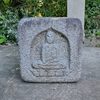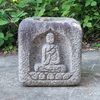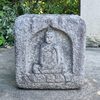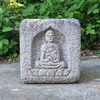A JAPANESE GRANITE CHÔZU’BACHI, 19TH CENTURY (LATE EDO PERIOD-MEIJI PERIOD)
Exceptional, traditional Japanese granite chôzu’bachi 手水鉢 (water basin) that is square of shape with on the top surface a cylindrical water pool and a carved design on each side of a Buddha figure seated in a mediative pose on a lotus throne surrounded by a cartouche with an accolade arch. All depicted seated in their own poses as they all represent a different Buddha: Yakushi 浄瑠璃 (Jôruri – East), Shakyamuni 釈迦 (Shaka – South), Amithaba 阿弥陀如来 (Amida – West) and Maitreya 弥勒 (Miroku – North).
This type of basin is known as ‘Shihôbutsugata chōzubachi’ 四方仏形手水鉢 (lit. ‘Four-Buddhas basin’), another pronunciation is Yohôbutsugata chōzubachi’. It is said that tea masters disliked the letter “shi” of Shihôbutsu and called it “Yohôbutsu” instead.
Chôzu’bachi, also known as a water reservoir for the hands, is an ornamental feature frequently encountered in traditional Japanese gardens. Its purpose extends beyond mere decoration, as it serves as a vessel for ritual hand washing and mouth cleansing. Prior to engaging in the tea ceremony or stepping onto sacred grounds like Buddhist temples and Shinto shrines, individuals partake in this purifying act. Chôzu’bachi embodies a profound cultural significance, emphasizing the importance of cleanliness and spiritual preparation in Japanese traditions.
Height: 36 cm.
Width & Depth: 34.5 cm.
The water pool:
Diameter: 20 cm.
Deep: 10 cm.
Weight: 99.5 kg.
In a very good original condition.






